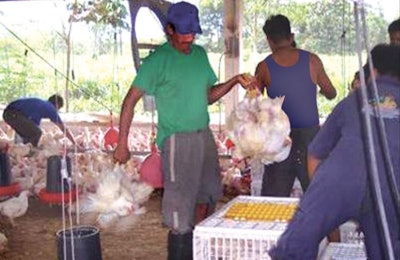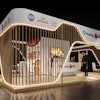
Management practices that minimize wing flapping from capture to processing can maximize quality and output at the processing plant.
Wing flapping is a broiler’s natural reaction to the stresses that come with harvesting, caging, transport and the initial stages of processing. But flapping can put enormous pressure on the bones in a bird’s thorax, leading to breakages and hemorrhaging.
This fight-or-flight reaction can harm the bird and those around it. There are, however, several stages from capture to processing where applying good practices can reduce losses.
Broiler harvesting
The peaceful atmosphere of the broiler shed will, inevitably, be disrupted by the arrival of the capture team, but workers can keep this disruption to a minimum by moving slowly and allowing the flock to adapt to their presence.
A failure to do so will lead to birds grouping together and climbing one on top of the other. Stress levels and flapping will increasing the risk of damage to the wings and likelihood of scratches to birds’ backs and thighs increase.
Any harm that birds sustain during capture will impact carcass quality at processing and may lead to downgrades.
Capture
It should always be remembered that there is a right and a wrong way to handle broilers. Capturing birds by one leg will lead to wing flapping as birds try to escape, and flapping will also occur if birds are captured by the body but the wings remain outside of the workers’ hands.
The correct way to capture birds is by the body, but with the wings held firmly to it.
Crating
As long as transport crates or cages are of good quality and in a good state of repair, it makes little difference what type is used. What does make a difference, however, is how birds are placed inside these containers.
There must be fully placed inside and equal care needs to be taken with the first and all subsequent birds. As each subsequent bird is placed inside the cage or crate, disturbance of those already inside needs to be kept to a minimum if they are not to react aggressively. Winging flapping within the confinement of the cage or container can be particularly harmful for the bird.
Transport to the plant
Poor road surfaces or careless can lead to the birds being jolted on their way to the processing plant. They will use their wings to help to regain balance which presents the same risks as mentioned above.
At the processing plant
In the same way that birds can be stressed during capture and transport, if their removal from cages is handled poorly wing flapping will increase. Correct lighting levels can also help to lower stress levels.
To reduce flapping once birds are shackled and on the overhead conveyor, a breast massager should be used.
Prevent pre-shock
Pre-shock should be prevented as birds approach the water bath as this will lead them to struggle and flap.
Additionally, pre-shock may result in birds lifting their meaning that they pass the stunning bath without being stunned.
The consequence of this will be that they will have their necks cut while still conscious and will struggle and flap due to the intense pain. Additionally, they may enter the scalder still partially alive, resulting in additional quality and sanitary issues.

















